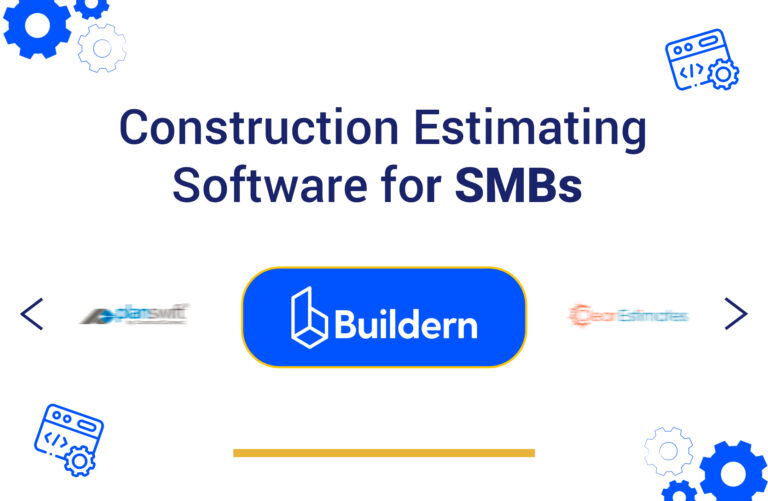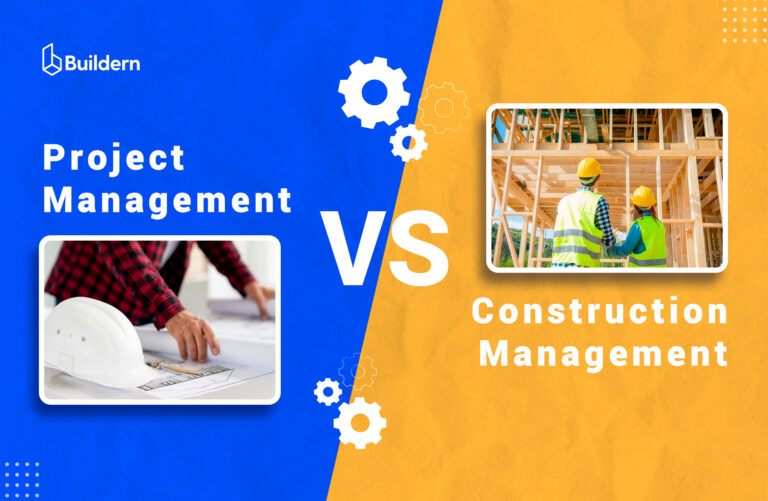What Is the Schedule of Values (SOV) in Construction: Complete Guide
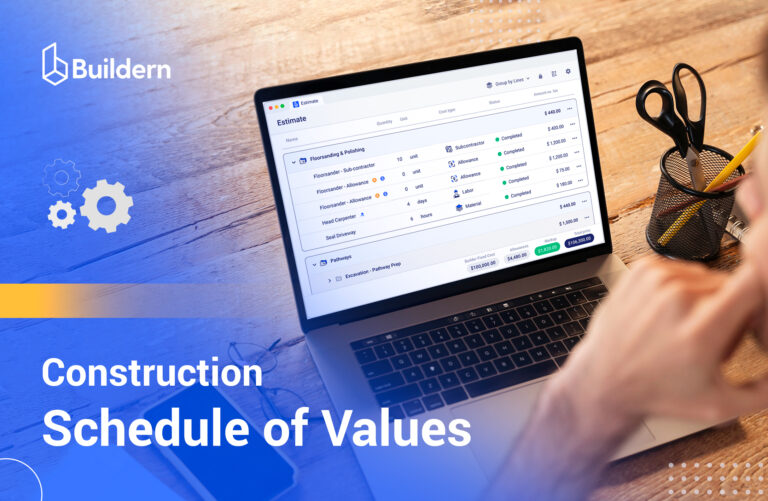
Ever been stuck waiting on a payment because something got “lost in the paperwork”? Or had a client question a line item on your invoice months into the job?
Those are exactly the problems the schedule of values (SOV) solves.
For most builders working on larger or bank-financed projects, the SOV acts as a must-have document that breaks down the total contract amount into detailed line items in construction financial management. It’s what keeps payment applications clean, project owners informed, and disputes to a minimum.
Table of Contents
- What Is a Construction Schedule of Values?
- Who Prepares the Schedule of Values?
- Schedule of Values Templates
- Cases When the Schedule of Values Is Used
- Final Thoughts: Why the SOV Matters

What Is a Construction Schedule of Values?
A Schedule of Values (SOV) is a detailed document used in construction projects to break down the total contract price into individual work items or cost categories. It’s your roadmap for billing and payment throughout the project lifecycle.
Instead of submitting a single lump-sum invoice, builders use the SOV to show how much work has been completed and how much is being billed for each item.
A typical schedule of values includes:
| Work Line Items | Each major phase or division of work is listed as a separate line item (e.g., site prep, framing, electrical, plumbing, finishes). |
| Scheduled Value per Line Item | A dollar amount is assigned to each line item, based on the original contract or subcontract. |
| Total Contract Value | The sum of all line items, listed at the bottom of the SOV. This should match the total contract amount. |
| Previous Payments | A column that tracks how much has already been billed and paid for each item. |
| Current Billing | Shows the amount being requested in the current payment application for each line item. |
| Balance to Finish | The remaining unpaid value for each line item (Total Value – Total Completed to Date). |
| % Complete | Indicates how much of each line item’s work has been completed, often based on inspections or progress reports. |
It’s very easy to create one using specialized construction project management software.
This helps builders keep every cost item under control, track the overall job costs, and ensure the whole team and clients are on the same page, literally.
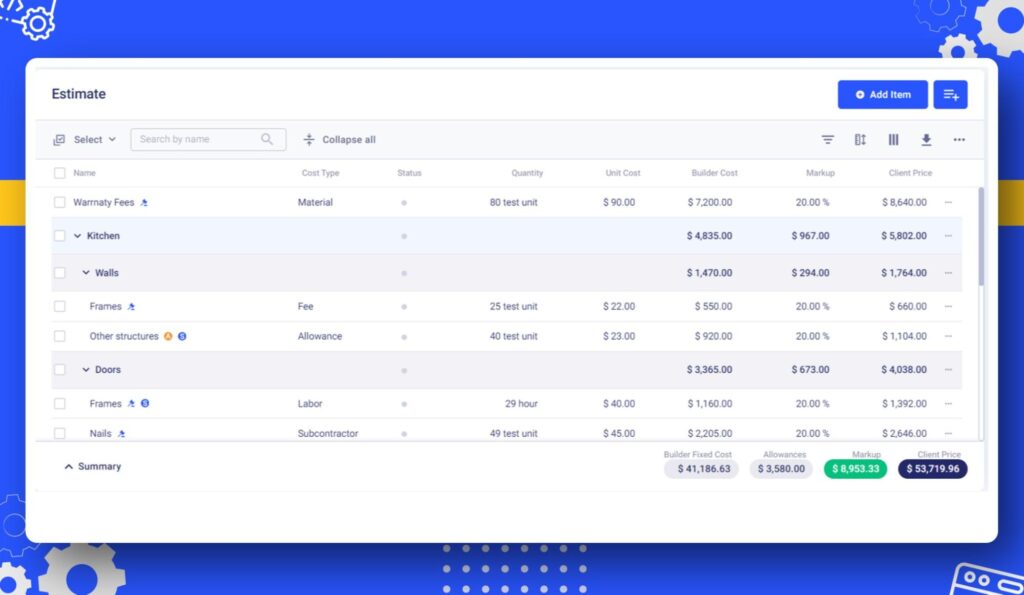
Why does this matter?
- Keeps billing transparent and organized
- Helps avoid payment delays or disputes
- Required for progress payments in many types of projects
- Makes life easier for general contractors, subcontractors, and owners alike
Who Prepares the Schedule of Values?
As a rule, general contractors (GCs) are responsible for preparing and submitting the schedules of values. In most cases, this happens when the contract is signed but the first payment application hasn’t been submitted yet.
The GC uses the contract scope and budget to break down the total value into logical, trackable pieces of work. If the project involves multiple sub/vendors, the GC might coordinate with them to ensure the values align with their scopes of work.
Some other stakeholders who may be involved in the process are:
- The client ot their representative who reviews and approves the SOV before payments begin.
- Architects or engineers (if applicable) who may be involved in the approval process, especially on AIA-managed projects.
- Sub/vendors who provide input for their specific work sections, but rarely submit the full SOV themselves.
Times When the SOV Is Required
- On progress billing projects, where payments are made based on completed work
- For bank-financed construction, where lenders require documentation of how funds are being used
- In larger or public-sector projects, where detailed cost tracking is part of compliance
Once approved, the SOV becomes a standard part of each payment application. Every invoice you submit will refer back to the line items and structure defined in this document.
Schedule of Values Templates
There’s no single accepted format for the schedule of values in construction, however, most construction teams use standardized templates to keep things clean and consistent.
Two common SOV templates are:
- AIA G703 Continuation Sheet: Widely used in commercial construction, this form breaks down the contract sum by line item and links directly to the AIA G702 payment application form. It’s a standard in architect-managed projects.
- ConsensusDocs 293: Schedule of Values: Offers a more flexible structure, often used in contractor-led or design-build projects. It aligns with the ConsensusDocs suite of contracts and forms.
💡Alternative Templates for SOV
If you’re using Buildern, your estimate already works as a schedule of values.
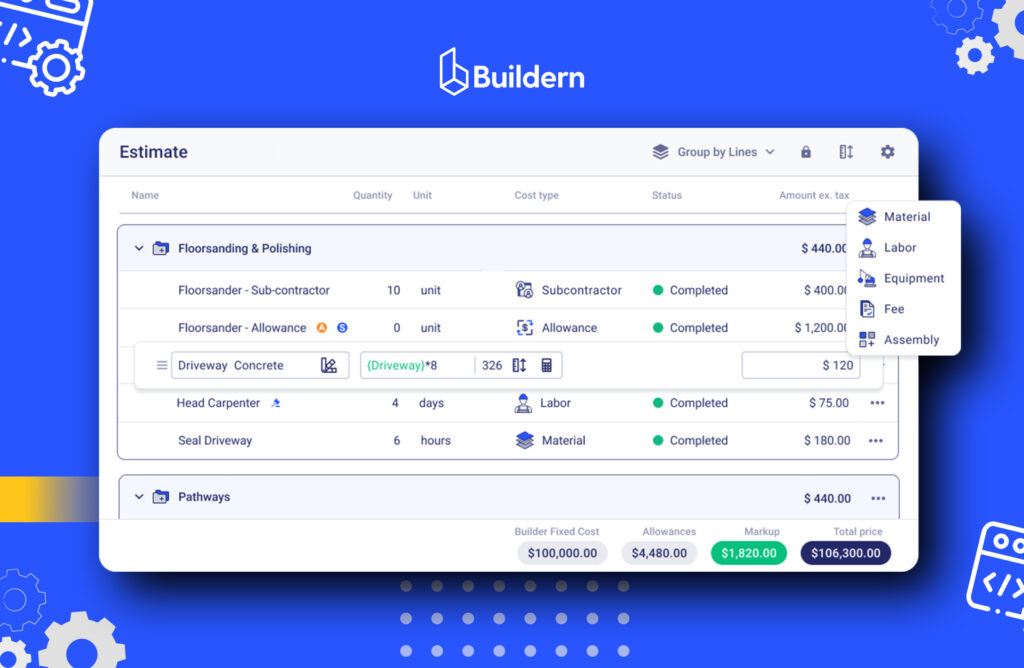
Every line item in your estimate can later be pulled directly into progress invoices with no double entry or extra forms required. Plus, Buildern supports change orders, cost tracking, invoicing, and so much more, giving you the same structure and transparency as a traditional SOV, with far less manual effort.
✅ Pro tip: Keep your estimate detailed and well-organized from the start. The more accurate it is, the easier you create proposals to win jobs and later on generate invoices to get paid on time.
Cases When the Schedule of Values Is Used
A schedule of values in construction isn’t just another form to fill out. View it as a practical tool used throughout the construction lifecycle to manage work, finances, and expectations.
Let’s look at the key ways builders use the SOV on real job sites.
Payment Management
At its core, the schedule of values is a billing tool. Laying the scope of work and assigning a specific value to each part, it becomes the foundation for all progress payments.
Builders use the SOV to show how much work has been completed during a billing cycle and request payment accordingly. For owners and lenders, this breakdown helps ensure payments are only released for completed work, minimizing the risk of overpaying upfront.
💡With Buildern, once the estimate is finalized, builders can add the line items into:
- Bid requests for the sub/vendors
- Purchase orders
- Subcontracts
- Bills
- Schedule
This means that everything here is interconnected, and once you set the base, everything works smoothly and automatically. These documents are then used throughout the whole project workflow and can be added to the invoices for timely payments.
Financial Planning and Cash Flow Management
Cash flow is one of the most critical aspects of running a healthy construction business. A schedule of values gives you visibility into when money is expected to come in and how much is tied to each phase of work. That allows project managers and accounting teams to plan purchases, manage payroll, and schedule subcontractors with confidence.
Instead of working off rough estimates or gut feeling, builders can look directly at the SOV to determine when they’ll receive funds for certain tasks and whether they need to adjust the timeline or resource allocations to stay financially balanced.
It’s especially useful for income and expense forecasting, especially in longer builds where payment schedules can stretch across months.
Change Order Management
No matter how well a project is planned, changes are inevitable.
Due to unforeseen circumstances or material shifts, change orders come into play making the SOV a powerful tool to document how that change affects the overall budget and payment structure.
💡While some builders may use various tools or even email communication for change order management, more advanced solutions like Buildern make the process much more manageable.
You can easily create change orders directly from your Buildern account and track their statuses in real time. Once the CO gets approved, you may add it to a subcontract or a purchase order to continue the workflow with zero disruptions.
Everything stays connected, your scope, budget, and later on invoices, which means less back-and-forth, fewer billing errors, and complete visibility for you and your client.
Cost Control
Tracking job costs against the original budget is key to protecting your profit margin.
A construction SOV lets you compare how much work has been billed versus how much was budgeted for each task. By monitoring this regularly, you can quickly catch overspending, identify cost-saving opportunities, or reallocate resources before a small issue becomes a major problem.
For general contractors juggling multiple trades and subs, the SOV also helps manage payouts fairly and in line with actual performance.
It gives everyone a clear understanding of where the money is going and how it aligns with the physical progress on site. That’s essential not just for the current project, but for building trust with clients and securing future work.
Conflict Resolution and Contractual Compliance
Finally, a detailed and well-prepared schedule of values can become a key reference point when something unexpected happens. Because the SOV documents exactly what work was assigned, how much was billed, and what’s been completed, it helps clarify misunderstandings and resolve conflicts based on facts instead of assumptions.
The SOV also plays an important role in staying contractually compliant. On projects where lenders or government agencies are involved, accurate and updated SOVs are often mandatory. Missing or outdated documents can slow down funding, trigger audits, or even put you at risk of breaching contract terms.
💡While Buildern isn’t a legal tool, having your entire billing history, estimates, and change orders stored and structured in one place can save you headaches if you ever need to justify your invoices or defend your work.
Final Thoughts: Why the SOV Matters
Whether you’re managing a small remodel or a multi-million-dollar commercial build, having a clear and accurate SOV saves time, reduces disputes, and keeps your cash flow steady.
With the right approach and tools to support your calculations and monitoring, SOV won’t be something too complicated. Ensure you approach this stage of construction project management wisely and trust the hard paperwork to professional software, so you have time to focus on the build.

What is the schedule of values document?
The Schedule of Values (SOV) is a breakdown of the total contract price into line items that represent different portions of work on a project. It’s used to support progress billing by showing how much each part of the job is worth, how much has been completed, and what’s being billed. It’s commonly submitted before the first invoice and used throughout the project to manage payments, track progress, and handle changes.
What does a SOV look like?
A typical SOV looks like a spreadsheet or form with multiple columns and rows. Each row lists a phase of work (like site prep, framing, electrical), and the columns show:
- The original value of that work
- Amount previously billed
- Amount currently billed
- Total completed to date
- Percentage complete
- Remaining balance
How to make a schedule of values?
To create a Schedule of Values, follow these steps:
- Start with your contract or project estimate.
- Break down the total value into logical line items (trades, phases, or deliverables).
- Assign a dollar amount to each line item based on its share of the total budget.
- Create columns to track billing and completion over time.
- Get it approved by the project owner or architect before submitting any payment applications.
